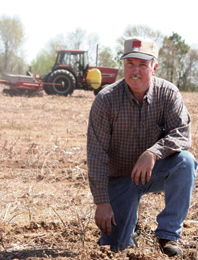Peanut Acreage Expected To Decrease in 2006

Alabama will see a 2 percent decrease in the combined acreages of four major row crops this year, according to the prospective planting report released by the Alabama Agriculture Statistics Service.The most notable is a 15.5 percent decrease in peanut acreage. Farmers plan to plant 190,000 acres of peanuts in 2006 — down 35,000 acres from 225,000 acres in 2005.Sammy Gibbs, a peanut farmer in Escambia County, says part of this decrease is due to a large carryover of peanuts from last year. “There needs to be more demand on peanuts for us to increase acreage,” said Gibbs. Randy Griggs, executive director of the Alabama Peanut Producers Association, agrees and says growers are just responding to supply and demand.”We have had three years of good production in the Southeast. This has generated a nationwide surplus of peanuts,” said Griggs, adding that Alabama is not alone in peanut acreage reduction.”The reduction is nationwide,” said Griggs. “The nationwide cut is 16 percent, so our’s is less than many states.”Still, the severity of the decrease was surprising to some. Buddy Adamson, cotton and feed grains director for the Alabama Farmers Federation, said the decrease was more “drastic” than he expected, but attributed some of the decline to a projected 13 percent increase in Alabama’s soybean acreage. “Soybeans have a significantly lower production cost,” said Adamson. “The increase in soybeans will be equal to the amount planted in 2003.”Nationally, soybean production is expected to increase only 7 percent, and cotton is expected to rise by 3 percent. Corn acreage is expected to decline by 5 percent. In Alabama, farmers expect to plant fewer acres of cotton this year. There were 550,000 acres of cotton planted in 2005, but only 540,000 acres are expected this year. However, all farmers are not following this trend. Gibbs is increasing his cotton plantings by 400 acres as part of his crop rotation plan. “Cotton grows very well behind peanuts,” said Gibbs. While Gibbs will be increasing some of his crops and decreasing others, some farmers are making an overall decrease. “I am reducing my plantings by 50 percent,” said Ed White of Henry County. “I am only planting my very best land where a good yield is more guaranteed.”White cites high fuel costs as the reason for his reduction.
“My fuel costs have tripled since three years ago,” said White, who’ll put cattle on the acreage that he will not be using for crops.Richard Edgar, president of the Elmore County Farmers Federation, says rising input costs continue to plague farmers trying to make a living. “Nitrogen fertilizer is up over $60 a ton from what it was last year; seed costs are up 5 to 10 percent. All our other chemicals are up 3 to 5 percent, and diesel fuel is up as much as 50 percent over last year. But commodity prices are about the same,” he said.Edgar says it’s the price of fuel that concerns him most. “That’s driving everything else,” he said. “We can alter some of our fertilizer rates and seeding rates and that kind of thing, but the fuel and the charge to have everything delivered here, and the fuel I burn, is driving up the cost of everything else.”Edgar says he’s planted 126 acres of wheat, which he’ll double crop with grain sorghum. In addition, he’ll be planting 310-315 acres of cotton and about 180-185 acres in corn.Gibbs, whose farm practices conservation tillage, says he sympathizes with farmers who till more. “I feel for the farmer who is doing more tilling. It’s going to cost him this year,” said Gibbs about the higher fuel prices.Brian Glenn, a wheat, soybean and corn farmer in Lawrence County, says fertilizer costs are also up.”We have some fertilizer stored on the farm,” he said. “We will not replenish our supply until we absolutely have to, but I hope costs eventually go down.”The statistics survey also reported that sorghum growers are expecting a 2,000-acre increase from last year while sweet potato producers are planning to plant 200 fewer acres. Hay acreage is anticipated to decrease by 3 percent. Acreages of corn, oats and winter wheat are likely to remain the same as 2005. According to the report, Alabama farmers expect to plant 220,000 acres of corn, the same as in the last two years.
Herb Vanderberry, director of the USDA’s Agricultural Statistics Service in Alabama, says weather will play a major role in how many acres farmers will actually plant. Vanderberry adds that another survey will be conducted June 1 to determine how many acres farmers actually planted.”I hope for fewer storms,” said Gibbs whose south Alabama farm has been battered by hurricane force winds for the last two years, “But, I have a good outlook. I have to because farming is in my blood.”
